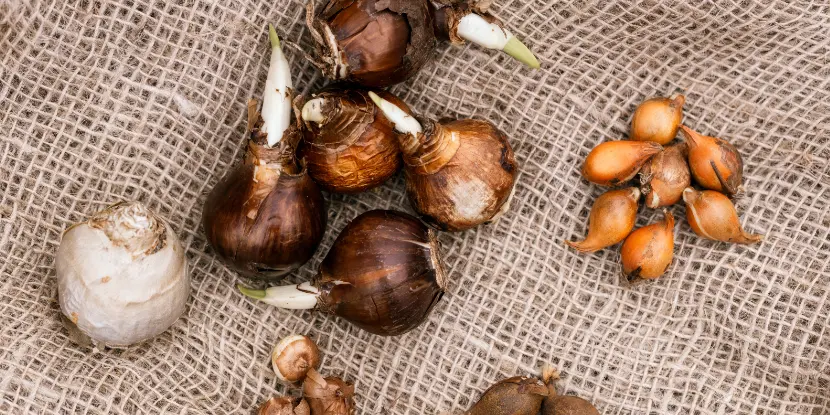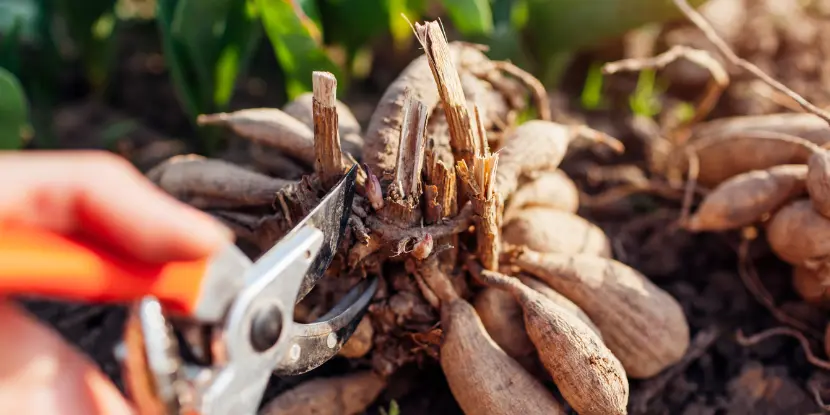The tulip hails from the cool mountain slopes of Kazakhstan.
It was introduced to the Netherlands in the early 1600s and quickly became a wealth and social status symbol. Tulip mania followed — the speculative buying and selling of tulip bulbs.
As demand grew, so did prices. Speculators invested heavily in rare tulip varieties. At the peak of this craze, some bulbs cost as much as luxury items, including houses.
In 1637, the bubble burst, collapsing tulip prices and leaving investors holding the bag — of tulip bulbs, that is.
The lesson for modern LA gardeners?
- Never pay too much for tulips.
- Stick with irises, gladiolus, and other bulbs that fare much better in sunny SoCal.
- Don’t judge a blog by its intro. We’ll get to the point soon enough.

Flowering gladiolus plants line a yard.
Best Flower Bulbs for Southern California Yards
Here’s a short list of bulbs that thrive in Southern California’s mild climate.
- Freesias have vivid and sweet-smelling flowers in various colors. They’re ideal for containers.
- Ranunculus have showy, rose-like white, pink, red, orange, and yellow flowers. Plant them in the fall for spring blooms.
- Daffodils bear bright and cheerful flowers with trumpet-shaped centers. They’re deer-resistant and long-lasting.
- Crocuses are some of the first flowers to bloom in spring, with striking purple, yellow, and white petals.
- Alliums have round, ball-shaped blooms in purple, blue, pink, and white shades. They add interest and texture to a garden.
- Lilies are easy to grow and make beautiful cut flowers. Plant them in full sun for best results.
- Cannas bear large, tropical-looking flowers in yellow, orange, red, and pink. They do well in containers or as dramatic focal points in a garden.
- Dahlias come in a range of colors, sizes, and shapes. They thrive in full sun with well-drained soil.
- Calla Lilies are elegant and graceful with their unusual funnel-shaped blooms. They prefer partial shade and moist, well-drained soil.
- Iris varieties include bearded iris, Siberian iris, and Dutch iris, among many others. They prefer full sun but can also tolerate partial shade.
- Gladiolus bulbs produce tall spikes of colorful flowers. They prefer well-drained soil and full sun, so plant them in a spot with plenty of light during the day.
- Hyacinths produce clusters of fragrant flowers and can be planted in the fall and winter for a beautiful spring display.
- Narcissus bulbs, or paperwhites, produce delicate white flowers and can be forced indoors in a container filled with pebbles and water.
- Tulips are cool-weather bulbs, but some varieties do well in Southern California gardens. Choose shorter species like the Greigii or Kaufmanniana tulip, which are more heat-resistant.

Various flower bulbs ready for planting.
Planting Tips for Bulbs
When it comes to planting bulbs, timing is everything. Most bulbs should be planted in fall or early winter for spring blooming. You want to give them enough time to establish their roots before the ground freezes.
Planting Tips for Bulbs
- Choose bulbs that are firm and free of any mold or damage.
- Consider factors such as sunlight exposure, soil type, and drainage for your planting location. Most bulbs flourish with at least six hours of direct sunlight daily.
- Before planting, loosen the soil and add organic matter if needed.
- Dig a hole 2–3 times deeper than the bulb’s height.
- Place the bulb in the hole with the pointed end facing up.
- Cover the bulb with soil and gently press down to remove air pockets.
- Water thoroughly after planting to help the roots establish.
- You can leave bulbs in the ground year-round in areas with mild winters. In colder climates, dig them up after the foliage dies back and store them in a cool, dry place until it’s time to plant again.

Most bulbs should be planted 2–3 times deeper than the bulb’s height.
Caring for Bulbs
- Water regularly; bulbs need consistent moisture. Keep the soil moist but not waterlogged.
- Add a layer of mulch around your bulbs to help retain moisture and suppress weeds.
- Apply a light layer of fertilizer in the fall or early spring when new growth appears.
- Remove dead flowers to encourage more blooms and prevent seed production.
- Leave foliage intact — Let the leaves die back naturally after blooming. This allows the bulb to store energy for next year’s growth.
- In mild climates, bulbs can be lifted and divided every two to three years to prevent overcrowding.

A gardener propagates dahlia bulbs by splitting
Methods of Propagating Bulbs
- Offsets: Most bulbous plants produce smaller bulbs called offsets around the parent bulb. Carefully separate these offsets from the parent plant during dormancy and replant them in a suitable location.
- Bulbils: Some bulb varieties, such as lilies and onions, produce bulb-like structures along their stems or in leaf axils. These can be collected and planted directly in the soil.
- Scaling involves removing scales from large bulbs, such as lilies, and placing them in a moist growing medium until they form small bulblets. Once the bulblets have developed, they can be replanted in the garden.
- Division: Certain plants like cannas and irises grow from rhizomatous or tuberous bulbs, which can be divided and replanted. Ensure each division has at least one shoot or growing point (like the eye of a potato).
- Seed: Although less common, some bulbs can be propagated from seed. This method takes longer for plants to mature and flower but can yield exciting new varieties and hybrids. Plant the seeds in a prepared seedbed or container and nurture them until they are large enough to transfer to their permanent location.
Steps for Growing Bulbs in Containers
- Choose a container with adequate drainage. The container should be deep enough to accommodate the bulbs’ planting depth.
- Fill the container with a well-draining potting mix enriched with compost or organic matter.
- Refer to the planting instructions specific to the type of bulb. Generally, bulbs should be planted at a depth of 2–3 times their height.
- Position the bulbs with the pointed end facing upwards. Space them according to the package instructions.
- After planting, water the bulbs thoroughly to settle the soil and initiate root growth.
- Place the container in an area that receives sufficient sunlight, usually with at least six hours of direct light daily.
- Keep the soil consistently moist but not soggy. Check the moisture levels regularly, especially in warmer weather.
- Apply a balanced, slow-release fertilizer at the onset of new growth. Avoid over-fertilizing, which can lead to excessive foliage at the expense of blooms.
- Remove dead flowers to prolong the blooming period and maintain the plant’s appearance.
- In regions with harsh winters, consider moving containers to a sheltered location or bringing them indoors to protect the bulbs from freezing temperatures.
Indoor bulbs should be first cultivated outdoors in the shade to provide as much cooling time as possible. This allows root growth before top growth begins. The most common causes of containerized bulb failure in Los Angeles and other warm-weather areas are warm winters with equally warm homes.
Tulips, crocus, hyacinths, muscari, narcissus, daffodils, and amaryllis are the most popular bulbs for container growing, but any bulb can be potted. All bulbs, except tulips, crocus, and hyacinths, can be planted as is.
These three bulbs must be refrigerated for at least six to eight weeks before planting. Don’t store bulbs in the freezer or vegetable sections of your refrigerator; don’t store them in plastic bags — use paper bags.

Flower bulbs growing in clay pots.
More Container Growing Tips
Gravel Small Pebbles (hyacinths & narcissus only)
- Fill a transparent or translucent, shallow container with gravel or small pebbles. Carefully place the bulb 1/2 way into the gravel. Use as many bulbs as will fit without touching each other or the sides of the container.
- Fill with tepid water to just below without touching the bulbs’ bottom. Keep the water level constant.
- Place the container outdoors in the coolest dark available. If bulbs are too warm, you’ll get beautiful foliage but no blooms.
- When growth reaches 4″ high, gradually move the container into more light. Too much light too fast will cause excess foliage growth, robbing the bulb of the energy needed to produce blooms.
Hyacinth Vase (hyacinths & narcissus only)
- Place the bulb in the cup of the vase.
- Fill the vase with tepid water to just below but not touching the bulb’s base.
- Keep the water level constant.
Potting Soil (all bulbs)
- Place bulbs so their tips are just below the pot rim and fill the pot without allowing bulbs to touch the side or each other.
- Avoid pressing bulbs into the soil, which can damage the bulb’s bases and hinder root growth.
- Water well and feed with Dutch Bulb Food, following label directions.
- Set the containers in a cool, shady location until the bulbs sprout — generally 6–10 weeks later, depending on the variety.
- Bring the bulbs indoors just as buds open, but keep them out of full sun while flowering to prolong blooming.
FAQs: Planting & Growing Bulbs
Q: When is the best time to plant bulbs?
Most bulbs should be planted in the fall before the ground freezes. However, some can also be planted in early spring.
Q: How deep should I plant my bulbs?
Generally, bulbs should be planted at 2–3 times their height. Refer to the specific planting instructions for each type of bulb.
Q: Can I plant bulbs in containers?
Yes, many types of bulbs can be grown in containers. Use a well-draining potting mix and follow watering and fertilization guidelines.
Q: How often should I water my bulbs?
Bulbs prefer moist but not soggy soil. Check the moisture levels regularly, especially in warmer weather.
Q: How long do bulbs take to bloom?
The blooming time for bulbs can vary depending on the type and growing conditions. Generally, they’ll bloom within 6–10 weeks after planting.
Q: Can I save my bulbs after flowering?
Some bulbs can be saved and replanted in subsequent years, while others are best treated as annuals. Refer to instructions for each type of bulb or consult a gardening expert.
Q: What should I do with bulbs after blooming in containers?
Allow the foliage to die back naturally, which helps the bulb store energy for the next flowering season. Keep watering consistently until the leaves have yellowed and died. Afterward, you can remove the spent foliage and replant the bulbs in the ground or store them in a cool, dry place until it’s time to replant.
Q: Why are my bulbs not blooming even though they have plenty of foliage?
If bulbs produce foliage but fail to bloom, it may be due to insufficient chilling time, particularly for those that require a cold period, like tulips, crocus, and hyacinths. Ensure these bulbs receive a minimum refrigeration period before planting. Overcrowding and lack of proper nutrients can also hinder blooming, so follow spacing guidelines and apply a balanced fertilizer.

